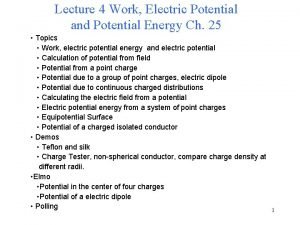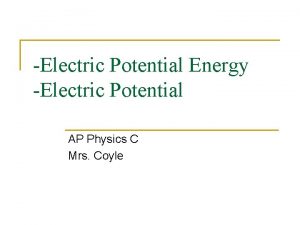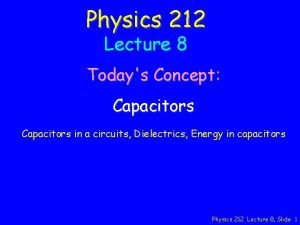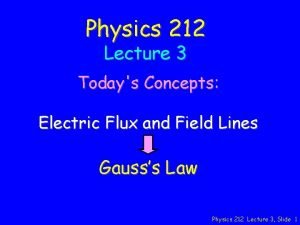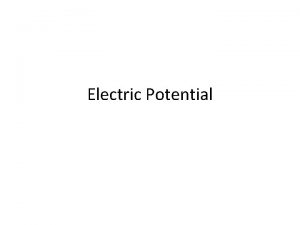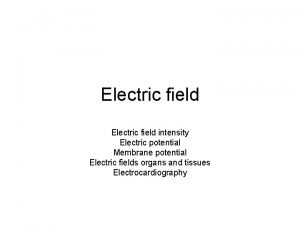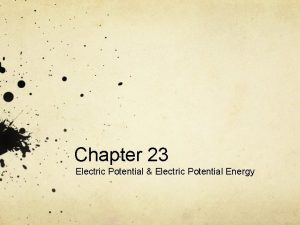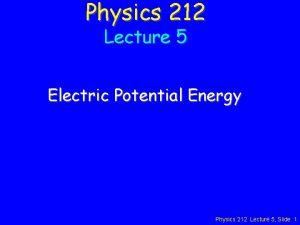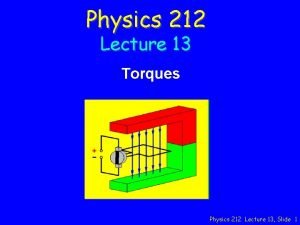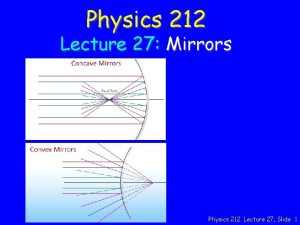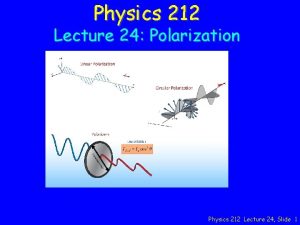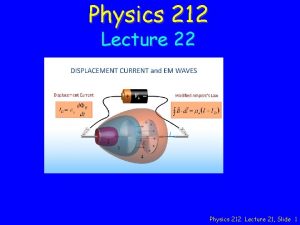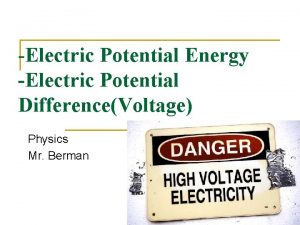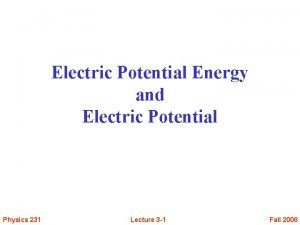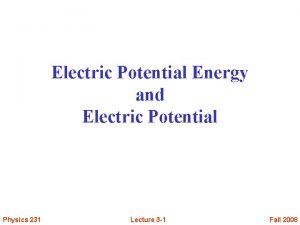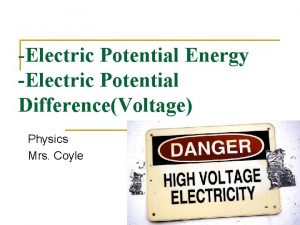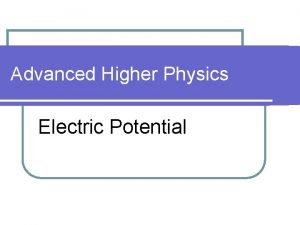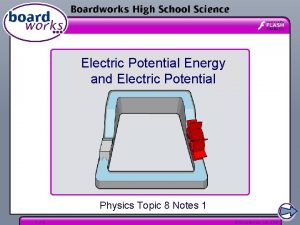Physics 212 Lecture 6 Electric Potential Physics 212























- Slides: 23

Physics 212 Lecture 6 Electric Potential Physics 212 Lecture 6, Slide 1

BIG IDEA • Last time we defined the electric potential energy of charge q in an electric field: • The only mention of the particle was through its charge q. • We can obtain a new quantity, the electric potential, which is a PROPERTY OF THE SPACE, as the potential energy per unit charge. V in Volts = Joules/Coulomb • Note the similarity to the definition of another quantity which is also a PROPERTY OF THE SPACE, the electric field. 40 Physics 212 Lecture 6, Slide 2

Electric Potential from E field • Consider the three points A, B, and C located in a region of constant electric field as shown. D Dx • What is the sign of DVAC = VC - VA ? (A) DVAC < 0 (B) DVAC = 0 (C) DVAC > 0 • Remember the definition: • Choose a path (any will do!) 40 Physics 212 Lecture 6, Slide 3

Checkpoint 2 A B C D • Remember the definition V is constant !! 08 Physics 212 Lecture 6, Slide 4

E from V • We obtain the potential by integrating the electric field: • So, we can obtain the electric field by differentiating the potential. • In Cartesian coordinates: 40 Physics 212 Lecture 6, Slide 5

Checkpoint 1 a • How do we get E from V? ? Look at slopes !!! 08 Physics 212 Lecture 6, Slide 6

Checkpoint 1 b A B C D • How do we get E from V? ? Look at slopes !!! 08 Physics 212 Lecture 6, Slide 7

Equipotentials • Equipotentials are the locus of points having the same potential. Equipotentials produced by a point charge Equipotentials are ALWAYS perpendicular to the electric field lines The SPACING of the equipotentials indicates The STRENGTH of the electric field 40 Physics 212 Lecture 6, Slide 8

Checkpoint 3 a A B C D 08 Physics 212 Lecture 6, Slide 9

Checkpoint 3 b A B C D 08 Physics 212 Lecture 6, Slide 10

HINT E - FIELD LINES A B C D EQUIPOTENTIALS • What is work done by E field to move negative charge from A to C ? (A) WAC < 0 (B) WAC = 0 (C) WAC > 0 A and C are on the same equipotential 08 Equipotentials are perpendicular to the E field: No work is done along an equipotential. WAC = 0 Physics 212 Lecture 6, Slide 11

Checkpoint 3 b Again? A B C D • A and C are on the same equipotential • B and D are on the same equipotential • Therefore the potential difference between A and B is the SAME as the potential between C and D 08 Physics 212 Lecture 6, Slide 12

Checkpoint 3 c A B C D 08 Physics 212 Lecture 6, Slide 13

cross-section a 4 a 3 +Q a 2 a 1 +q metal Point charge q at center of concentric conducting spherical shells of radii a 1, a 2, a 3, and a 4. The inner shell is uncharged, but the outer shell carries charge Q. What is V(r) as a function of r? metal - Charges q and Q will create an E field throughout space – – 40 Spherical symmetry: Use Gauss’ Law to calculate E everywhere Integrate E to get V Physics 212 Lecture 6, Slide 14

a 4 a 3 r > a 4 : What is E(r)? +Q a 2 a 1 (A) 0 (B) (C) +q metal r (D) (E) metal Why? Gauss’ law: Physics 212 Lecture 6, Slide 15

a 4 a 3 +Q a 2 a 1 (A) 0 +q metal a 3 < r < a 4 : What is E(r)? r (B) (D) (C) (E) metal Applying Gauss’ law, what is Qenclosed for red sphere shown? (A) q (B) –q (C) 0 How is this possible? ? ? -q must be induced at r=a 3 surface charge at r=a 4 surface = Q+q Physics 212 Lecture 6, Slide 16

a 4 a 3 +Q a 2 a 1 +q metal Physics 212 Lecture 6, Slide 17

a 4 a 3 +Q First find V(r) for r a 4 a 2 a 1 +q metal 0 For r a 4 Just like a point charge ! So…

a 4 a 3 +Q How about V(r) for a 2 a 1 ? +q metal 0 V( r ) constant inside a conductor !

a 4 a 3 +Q V(r) for a 2 a 1 +q metal 0 ?

a 4 a 3 +Q ? V(r) for a 2 a 1 +q metal 0 0

a 4 a 3 +Q V(r) for a 2 a 1 ? +q metal 0 0

Summary V 0 a 1 a 2 a 3 a 4 r
 Electric field lines
Electric field lines Electric potential lecture
Electric potential lecture Electric potential lecture
Electric potential lecture Equipotential lines
Equipotential lines Electric potential unit
Electric potential unit Electric potential
Electric potential Potential due to charged sphere
Potential due to charged sphere V=pe/q
V=pe/q Potential formula
Potential formula Electric field and electric potential
Electric field and electric potential Ap physics c electric potential
Ap physics c electric potential Q=vc physics
Q=vc physics Physics 212 gradebook
Physics 212 gradebook 01:640:244 lecture notes - lecture 15: plat, idah, farad
01:640:244 lecture notes - lecture 15: plat, idah, farad Why is water potential measured in pascals
Why is water potential measured in pascals Water potential equation
Water potential equation Understanding water potential
Understanding water potential Neuronal pool
Neuronal pool Nerve action potential
Nerve action potential Definition of graded potential
Definition of graded potential Difference between action and graded potential
Difference between action and graded potential Absolute refractory period
Absolute refractory period How to find pressure potential
How to find pressure potential Sources of bioelectric potentials
Sources of bioelectric potentials

